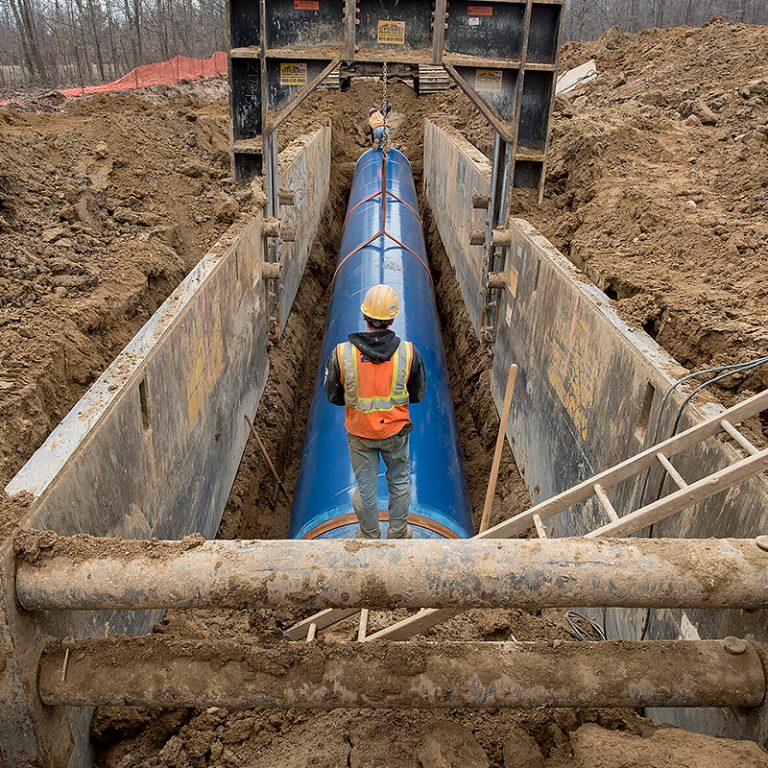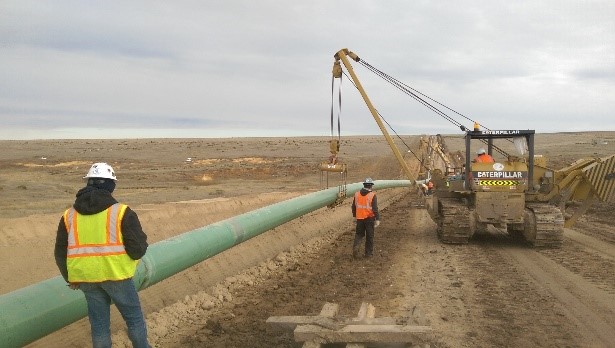Success Begins With Proper Creek Pipe HDPE installation
Wiki Article
The Significance of Pipeline Construction: Exploring the Providers Provided in the Sector
Pipeline construction is an essential element of modern-day facilities. It promotes the transportation of essential resources like oil, gas, and water. The sector incorporates different solutions, including preparation, site prep work, and installation. Each phase calls for precision and adherence to safety and security standards. As neighborhoods depend on these systems for their source of incomes, understanding the ins and outs of pipe construction reveals its relevance and potential difficulties. What variables influence the success of these jobs?Review of Pipeline Construction Services
Pipeline construction services incorporate a range of specific tasks made to help with the setup of pipes for transporting different compounds, consisting of oil, gas, and water. These services usually consist of website preparation, excavation, installation of pipeline sections, and backfilling. Knowledgeable labor and advanced equipment are essential for ensuring each stage is implemented with accuracy and safety.Safety protocols are paramount, as these jobs typically entail dealing with harmful products and in tough settings. Quality assurance actions ascertain that the pipelines meet industry standards and regulations. Additionally, the services might entail trenchless modern technology, which decreases surface area disruption.Environmental factors to consider play a substantial duty in pipe construction, needing evaluations and mitigations to safeguard surrounding communities. In general, pipeline construction solutions are crucial for developing the framework needed for energy and water distribution, sustaining both financial growth and societal demands.Preparation and Style in Pipeline Projects
Efficient planning and design are essential parts of successful pipeline tasks, making certain that all elements are carefully dealt with before construction starts. This stage includes extensive feasibility studies that analyze the technological, economic, and ecological aspects influencing the task. Designers and designers team up to produce comprehensive plans that detail the pipeline course, materials, and construction methods, straightening with regulative needs and market standards.Advanced software and modeling methods are frequently used to mimic numerous situations, maximizing the style for efficiency and security. Ecological impact evaluations are conducted to alleviate potential damage to ecosystems and neighborhoods, mirroring a commitment to lasting techniques. Furthermore, stakeholder involvement is important, promoting interaction and dealing with worries from affected celebrations. Inevitably, reliable planning and style established the structure for a pipeline job, decreasing risks and making certain a structured construction procedure, inevitably contributing to the general success of the procedure.Website Prep Work and Excavation
Comprehensive site prep work and excavation are essential action in the pipeline construction process. This stage entails a thorough assessment of the land where the pipeline will be set up. Job groups carry out studies to recognize dirt kinds, topography, and existing energy lines to guarantee a safe and efficient excavation. Proper site preparation reduces environmental effect and assists in smoother construction operations.Excavation adheres to, where hefty equipment is used to get rid of dirt and rock, developing a trench that fulfills the defined deepness and size for the pipeline. This process should follow safety policies and environmental guidelines to avoid damage to bordering ecosystems.Additionally, disintegration control procedures are carried out to support the site during and after excavation. Reliable website prep work and excavation contribute significantly to the general success of pipeline tasks, laying a strong structure for the subsequent phases of construction.Pipeline Installation Strategies
Pipeline installation strategies are necessary for the effective implementation of infrastructure tasks. 2 popular methods consist of trenchless modern technology, which reduces surface disturbance, and the open-cut excavation procedure, understood for its straightforward strategy. Each method supplies unique benefits and factors to consider relying on job requirements and ecological aspects.Trenchless Innovation Approaches
While standard methods of pipe setup typically involve considerable excavation, trenchless innovation approaches use a more reliable and environmentally pleasant alternative. These cutting-edge techniques, such as straight directional drilling and pipeline bursting, minimize surface area disruption by enabling for the installation of pipelines without considerable digging. This not just decreases the ecological impact however additionally greatly minimizes labor and remediation prices. Trenchless methods assist in the installation of pipelines in city locations where conventional excavation would certainly be not practical or damaging to existing facilities. In addition, these techniques can fit numerous dirt types and conditions, making them flexible remedies for pipeline construction. Ultimately, trenchless innovation stands for a substantial development in the pipeline market, advertising sustainability and functional efficiency.
Open-Cut Excavation Refine
Open-cut excavation continues to be a basic strategy in pipe installment, identified by the straight excavation of a trench to lay pipelines. This technique includes eliminating soil and other materials to create a trench of sufficient deepness and size, permitting the positioning of pipes at the needed grade. Open-cut excavation is frequently preferred for its cost-effectiveness and simplicity, specifically in locations with steady soil conditions. However, it can interfere with surface area activities and requires careful preparation to handle web traffic and environmental impacts. Precaution have to be applied to secure workers and neighboring framework during the excavation procedure. Generally, while open-cut excavation may not appropriate for all surfaces, it remains an extensively made use of approach in pipeline construction.Examining and Quality Control
Checking and quality control are important components in pipe construction, making sure that installations fulfill recognized safety and security requirements and efficiency demands. Numerous assessment techniques and techniques are employed to examine worldly high quality and adherence to governing compliance. This organized approach assists identify prospective concerns before they intensify, guarding the stability of the pipe system.
Assessment Techniques and Methods
Examination methods and approaches are vital components in making sure the integrity and security of pipe construction. Different strategies, including aesthetic inspections, ultrasonic testing, and radiographic exams, are utilized to identify problems and validate quality. Visual examinations permit the recognition of surface area anomalies, while ultrasonic testing makes use of acoustic waves to evaluate wall surface density and locate problems inside. Radiographic examinations include X-rays or gamma rays to generate photos of the pipeline's structure, exposing surprise issues. Furthermore, stress screening is performed to evaluate the pipeline's stability under functional problems. These approaches jointly add to a complete understanding of the pipe's problem, enabling timely maintenance decisions and making sure conformity with sector criteria. Reliable inspection is crucial for stopping failings and promoting long-lasting operational security.Security Specifications Conformity
Making sure conformity with safety and security criteria is extremely important in pipe construction, as it straight influences the project's overall quality and reliability. Sticking to established regulations and standards warranties that construction techniques alleviate threats connected with pipeline installation and operation. Creek Pipe reviews. Rigorous screening methods, consisting of non-destructive testing and pressure evaluations, are vital in validating that pipes can stand up to the operational stresses they will certainly come across. Quality control steps are also crucial, as they develop a framework for regular tracking and evaluation throughout the construction procedure. By prioritizing safety requirements compliance, firms not only protect employees and the setting yet likewise enhance the stability of the pipeline, inevitably resulting in lasting operational success and public count on the facilitiesMaterial High Quality Evaluation
Product quality examination plays a significant duty in the overall stability of pipe construction. This process entails rigorous screening and quality control actions to ensure that products meet market criteria and specifications. Different examinations, including tensile stamina, deterioration resistance, and weld integrity evaluations, are performed to identify any type of possible weaknesses. A complete evaluation not only ensures the efficiency of the pipe but likewise boosts safety and security and sturdiness over its life-span. In addition, implementing high quality control procedures aids mitigate risks associated with material failings, which can cause pricey repairs and environmental risks. By prioritizing material high quality examination, firms can assure conformity with governing needs while fostering confidence among stakeholders in the reliability of their pipeline systems.Maintenance and Repair Work Solutions
Repair and maintenance solutions play an essential role in the longevity and efficiency of pipeline systems. These services encompass normal inspections, troubleshooting, and corrective activities to resolve damage, leakages, and various other concerns that might occur in time. Skilled specialists use advanced innovations such as ultrasonic testing and smart pigging to monitor pipe stability, making sure that any type of potential troubles are determined early.Additionally, maintenance programs frequently consist of set up safety nets designed to boost system dependability and reduce the chance of unforeseen failures. Repair solutions may involve the substitute of damaged areas, sealing leakages, or utilizing trenchless technology for very little disruption.Environmental Conformity and Precaution
Pipeline systems not only need continuous upkeep and repair service to function successfully but additionally should stick to strict ecological compliance and safety and security steps. These laws are vital for minimizing eco-friendly impact and making sure public safety. Business in the pipe construction industry carry out thorough ecological analyses before job initiation, recognizing potential dangers to wild animals and ecosystems.Furthermore, adherence to safety procedures shields workers and surrounding areas. This consists of regular training on emergency situation feedback and spill prevention techniques.To preserve conformity, markets make use of keeping track of modern technologies to detect leaks and other abnormalities in real-time. Ecological monitoring plans are frequently established to lay out actions for addressing unexpected problems throughout construction.Ultimately, rigorous adherence to ecological conformity and precaution not only fulfills legal responsibilities however likewise promotes lasting methods within the sector, advertising an equilibrium in between facilities growth and ecological stewardship.Often Asked Concerns
What Occupation Opportunities Are Readily Available in Pipeline Construction?
Job possibilities in pipe construction include functions such as job managers, engineers, welders, and safety inspectors. These positions call for varied abilities, offering pathways for growth in an important industry of infrastructure development and power circulation.

Exactly How Do Pipeline Projects Effect Citizen Communities?
Pipeline jobs significantly impact neighborhood neighborhoods by influencing financial development, offering job possibilities, and improving infrastructure. However, they might also elevate worries about ecological impacts, land use, and possible interruptions to area communication and natural ecological communities.
What Innovation Is Made Use Of in Modern Pipeline Construction?
Modern pipeline construction makes use of advanced modern technologies such as GIS for mapping, drones for aerial studies, and automated welding systems to boost effectiveness, safety and security, and precision, inevitably facilitating the efficient transport of resources throughout numerous terrains. Creek Pipe HDPE installation.How Are Pipeline Construction Expenses Approximated?
Pipeline construction prices are estimated with in-depth analyses of materials, labor, devices, and governing requirements. Elements like surface, task size, and environmental considerations likewise substantially influence the overall budget plan and monetary preparation for construction.What Are the Biggest Challenges in Pipeline Construction Projects?
The most significant difficulties in pipe construction tasks consist of governing conformity, ecological concerns, logistical issues, securing funding, and handling labor lacks. Each aspect can considerably influence timelines and spending plans, making complex the Creek Pipe Texas oilfield total execution of the project.Report this wiki page